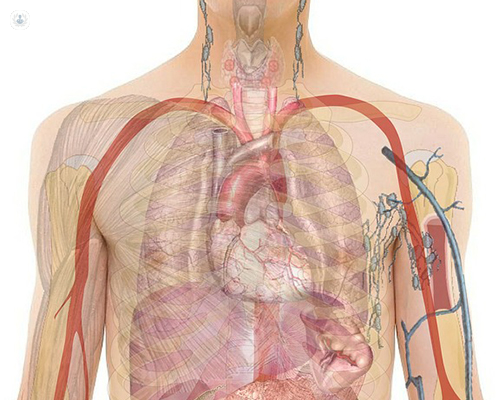How your heart may be affecting your lungs
Written by:Did you know that shortness of breath may actually be caused by problems of the heart? One of these is called pulmonary hypertension (PH). But what causes pulmonary hypertension and how does it affect the lungs? Dr Francesco Lo Giudice, consultant cardiologist expert in this condition, explains it all in this follow-.up article from his first on shortness of breath.

How does shortness of breath link to or impact pulmonary hypertension?
Pulmonary hypertension is a condition where the pressure in the lung circulation is higher than usual and this can affect the right side of the heart.
Our heart is made of four chambers that work pumping blood in two circulations: systemic (all organs) and pulmonary (lungs). The left side pumps blood to all the body, supplying oxygen to the brain and all the other organs. The right side pumps blood to the lungs where it can be properly oxygenated. In the lungs, the circulation is a low resistance circulation and the pressure is low. When the resistance in the lung circulation is high, due to various conditions, the pressure increases.
When the increase of pressure in the lung circulation reaches certain values we call it PH, and this could be one of the reasons for the shortness of breath. Usually the patient is referred to our service, one of the UK national service for PH, because of an abnormal echocardiogram (scan of the heart using ultrasounds) done to investigate shortness of breath. Our job is to identify the cause of PH and eventually treat it.
Most of the time, especially in aged patients, it is related to problem on the left side of the heart affecting also the right. Other times, especially in young patients, can be a very rare condition called “pulmonary arterial hypertension” (PAH), associated with other conditions or the cause is unknown, or there is a genetic link, especially if there are other family members with the same disease.
Finally, PH can be due to previous clots in the lungs, so called “chronic thromboembolic pulmonary hypertension” (CTEPH).
What exactly is pulmonary hypertension and what causes it?
Most of the times (nearly 70 per cent), PH is due to a problem on the left side of the heart affecting also the right. When the left ventricle, the main chamber that pumps blood to all the body, doesn’t work well because it becomes bigger or stiffer due to several other reasons, the pressure inside rises, and in turn these affect the lung circulation and the right side of the heart. This could be related to problems such as:
- ischaemic heart disease (myocardial infarction or heart attack)
- high blood pressure
- diabetes
- arrhythmias (like atrial fibrillation)
- diseases of the valves in the left side of the heart (mitral or aortic valves)
- amyloidosis
The higher the age of the patient and the more cardiovascular risk factors present (high blood pressure, diabetes, obesity, smoking history), the greater the possibility the patient has this form of PH. This becomes even more frequent as the population ages.
The second most frequent form of PH is the one associated with lung diseases, as:
- COPD (chronic obstructive pulmonary disease)
- emphysema
- interstitial lung disease (lung fibrosis)
- sarcoidosis
Rarely, PH can be associated with:
- autoimmune or connective tissue diseases (eg. scleroderma, rheumatoid arthritis, lupus)
- congenital (from birth) heart disease, previously treated with surgery or never discovered before
- liver diseases (mainly cirrhosis with portal hypertension)
- previous infectious diseases (eg. HIV, hepatitis, schistosomiasis)
- use of specific drugs in the past (eg. anorectic, taken to lose weight)
Sometime we rule out all the known causes and we call it “idiopathic”. Other times there are other family members affected and we call it “familiar” or “heritable” because sometimes we are able to identify modified genes as the cause.
As mentioned before, sometimes the cause is an old clot in the circulation of the lungs, obstructing the blood circulation. We call it chronic thromboembolic disease and this can cause also PH (chronic thromboembolic pulmonary hypertension or CTEPH). Interestingly, 20 to 30 per cent of the time patients never had a clear clots in the lungs (pulmonary embolus) or in the legs (vein thrombosis), therefore can be easily missed.
It is very important to diagnose this condition because it is the only one that can be treated very efficiently with surgery. The surgeon removes the scar inside the vessels of the lungs restoring the blood flow with a full recovery in more than 70 per cent of the cases.
If the surgical treatment is not an option or there is residual PH after surgery, we can consider a treatment with tablets or a procedure called “angioplasty”, using a balloon catheter to dilate the narrowed vessels.
Unfortunately, we still do not have a cure for the other forms of PH but we have several medications that can improve the symptoms and therefore the quality of life of our patients, with also the aim of slowing down the progression of this chronic condition and increase survival.
If you are experiencing shortness of breath recently or would like more information, you can schedule a consultation at Dr Lo Giudice's profile.


